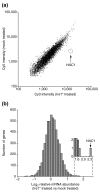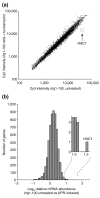Genome-scale approaches for discovering novel nonconventional splicing substrates of the Ire1 nuclease
- PMID: 15642095
- PMCID: PMC549064
- DOI: 10.1186/gb-2004-6-1-r3
Genome-scale approaches for discovering novel nonconventional splicing substrates of the Ire1 nuclease
Abstract
Background: The unfolded protein response (UPR) allows intracellular feedback regulation that adjusts the protein-folding capacity of the endoplasmic reticulum (ER) according to need. The signal from the ER lumen is transmitted by the ER-transmembrane kinase Ire1, which upon activation displays a site-specific endoribonuclease activity. Endonucleolytic cleavage of the intron from the HAC1 mRNA (encoding a UPR-specific transcription factor) is the first step in a nonconventional mRNA splicing pathway; the released exons are then joined by tRNA ligase. Because only the spliced mRNA is translated, splicing is the key regulatory step of the UPR.
Results: We developed methods to search for additional mRNA substrates of Ire1p in three independent lines of genome-wide analysis. These methods exploited the well characterized enzymology and genetics of the UPR and the yeast genome sequence in conjunction with microarray-based detection. Each method successfully identified HAC1 mRNA as a substrate according to three criteria: HAC1 mRNA is selectively cleaved in vitro by Ire1; the HAC1 mRNA sequence contains two predicted Ire1 cleavage sites; and HAC1 mRNA is selectively degraded in tRNA ligase mutant cells.
Conclusion: Within the limits of detection, no other mRNA satisfies any of these criteria, suggesting that a unique nonconventional mRNA-processing mechanism has evolved solely for carrying out signal transduction between the ER and the nucleus. The approach described here, which combines biochemical and genetic 'fractionation' of mRNA with a novel application of cDNA microarrays, is generally applicable to the study of pathways in which RNA metabolism and alternative splicing have a regulatory role.
Figures





References
-
- Kaufman RJ. Stress signaling from the lumen of the endoplasmic reticulum: coordination of gene transcriptional and translational controls. Genes Dev. 1999;13:1211–1233. - PubMed
-
- Travers KJ, Patil CK, Weissman JS. Functional genomic approaches to understanding molecular chaperones and stress responses. Adv Protein Chem. 2002;59:345–390. - PubMed
Publication types
MeSH terms
Substances
LinkOut - more resources
Full Text Sources
Other Literature Sources
Molecular Biology Databases

